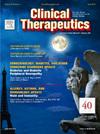肺栓塞患者心率变异性的短期预后价值:双中心队列研究。
IF 3.6
4区 医学
Q2 PHARMACOLOGY & PHARMACY
引用次数: 0
摘要
目的:肺血栓栓塞(PTE)是第三常见的急性心血管综合征,未经治疗的患者有严重的后遗症。心率变异性(HRV)已成为不良事件的关键和确定的预后指标。然而,其与PTE的相关性及其在预测不良后果方面的预后意义值得进一步研究。本研究旨在探讨HRV在预测PTE患者30天主要不良心血管事件(mace)中的预后作用。方法:本回顾性队列研究在2个中心进行,纳入170例PTE患者和174例对照组,他们接受24小时动态心电图记录,并评估时域HRV。简化肺栓塞严重程度指数为0分的PTE患者为低危组,≥1分的PTE患者为中危组。采用受试者工作特征曲线分析、cox -回归和Kaplan-Meier曲线检验评估HRV与MACE之间的相关性。结果:与对照组和中危PTE组相比,所有PTE患者的时域HRV均低于低危PTE组(P < 0.05)。随访期间共有22例PTE患者出现MACE。降低HRV的PTE患者发生MACE的风险增加(log-rank P < 0.05)。HRV是MACE的独立预测因子,所有正态与正态RR区间的标准差(风险比[HR], 0.968;95% CI, 0.950-0.986, P = 0.001), 5分钟平均N-N间隔的标准差(HR, 0.974;95% ci, 0.958-0.990, p = 0.002)。结论:HRV是一个独立的危险因素,与PTE患者30天不良预后相关,因此,HRV可被视为PTE患者风险分层的工具。本文章由计算机程序翻译,如有差异,请以英文原文为准。
Short-term Prognostic Value of Heart Rate Variability in Pulmonary Embolism Patients: 2-Center Cohort Study
Purpose
Pulmonary thromboembolism (PTE) is the third most frequent acute cardiovascular syndrome, with serious sequelae in untreated patients. Heart rate variability (HRV) has emerged as a crucial and established prognostic indicator for adverse events. Nevertheless, its correlation with PTE and its prognostic significance in anticipating adverse outcomes warrant additional investigation. This study sought to examine the 30-day prognostic utility of HRV in predicting major adverse cardiovascular events (MACEs) in individuals with PTE.
Methods
This retrospective cohort study, conducted at 2 centers, enrolled 170 patients diagnosed with PTE and 174 control subjects who underwent 24-hour Holter recording, with an evaluation of time-domain HRV. PTE patients with simplified-Pulmonary-Embolism-Severity Index = 0 points are classified as a low-risk group, and ≥1 as an intermediate-risk group. The association between HRV and MACE was assessed using receiver operating characteristic curve analysis, Cox-regression, and Kaplan–Meier curve tests.
Findings
Time-domain HRV was reduced in all PTE patients compared with the control group and intermediate-risk PTE than in low-risk PTE groups (P < 0.05). A total of 22 PTE patients developed MACE during follow-up. PTE patients with reduced HRV have an increased risk of MACE (log-rank P < 0.05). HRV was an independent predictor of MACE, the standard deviation of all normal-to-normal RR intervals (hazard ratio [HR], 0.968; 95% CI, 0.950–0.986, P = 0.001), and the standard deviation of 5-minute mean N-N interval (HR, 0.974; 95% CI, 0.958–0.990, P = 0.002).
Implications
HRV is an independent risk factor and is associated with 30-day poor outcomes in PTE. Thus, HRV can be considered as a tool in the risk stratification of PTE patients.
求助全文
通过发布文献求助,成功后即可免费获取论文全文。
去求助
来源期刊

Clinical therapeutics
医学-药学
CiteScore
6.00
自引率
3.10%
发文量
154
审稿时长
9 weeks
期刊介绍:
Clinical Therapeutics provides peer-reviewed, rapid publication of recent developments in drug and other therapies as well as in diagnostics, pharmacoeconomics, health policy, treatment outcomes, and innovations in drug and biologics research. In addition Clinical Therapeutics features updates on specific topics collated by expert Topic Editors. Clinical Therapeutics is read by a large international audience of scientists and clinicians in a variety of research, academic, and clinical practice settings. Articles are indexed by all major biomedical abstracting databases.
 求助内容:
求助内容: 应助结果提醒方式:
应助结果提醒方式:


